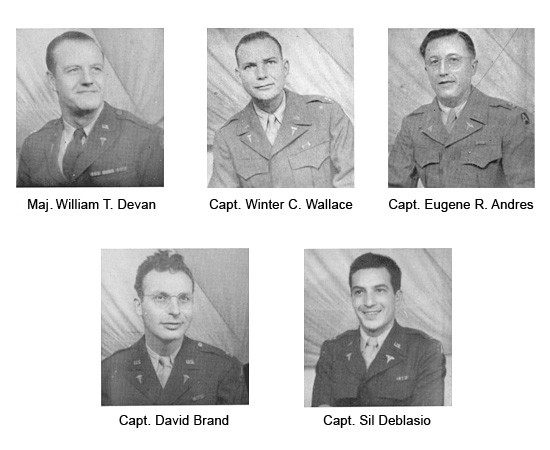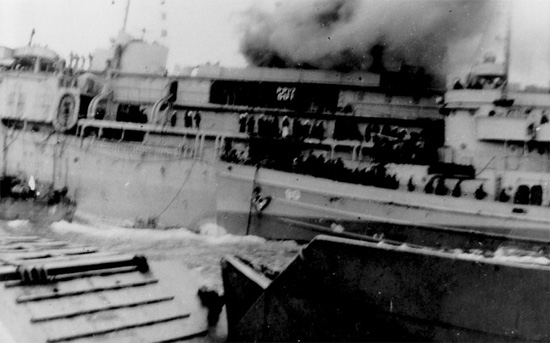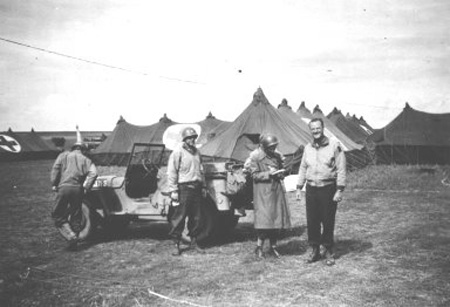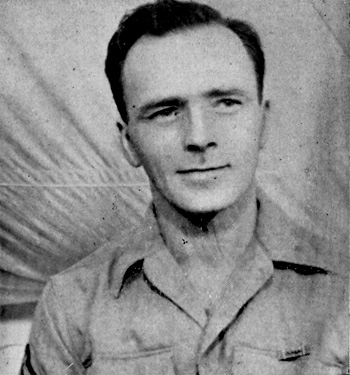2d Hospitalization Unit, 42d Field Hospital Unit History

Cover of Second Platoon, 42d Field Hospital Newsletter “From D-Day to V-Day“.
Activation & Training:
The 42d Field Hospital was activated 15 July 1943 at Camp Carson, Colorado Springs, Colorado (Division Camp; acreage 68,355; troop capacity 2,707 Officers and 44,240 Enlisted Men –ed). The organization was based on T/O 8-510, dated 8 April 1943, later reorganized as per T/O & E 8-510 dated 28 September 1943 (including changes C1, C2, and C3) with an authorized strength of 22 Officers, 18 Nurses, and 190 Enlisted Men. The 400-bed mobile unit consisted of a Headquarters and three (3) Hospitalization Units (or Platoons), each capable of operating independently of the others.
The Mobilization Training Programs 8-1 and 8-10 were completed during the months following the organization’s activation and lasted until 8 December 1943, with the unit subsequently departing for Laurinburg-Maxton Army Air Base, North Carolina (Glider Training Center, activated 28 August 1942, home of the First Troop Carrier Command –ed), where it was to receive Airborne training until 23 December 1943. The unit then moved to Fort Bragg, Fayetteville, North Carolina (Field Artillery Replacement Training Center –ed) where it remained until 16 February 1944. During its stay at the above Post quite a number of additional Medical Officers and Nurses joined the Hospital. Specialized training consisting of classroom lectures combined with field exercises continued, until it was felt that the unit was ready for a new assignment.
Preparation for Overseas Movement:
After receiving the necessary “Alert’ orders, the 42d Field Hospital departed Fort Bragg 16 February 1944 for Camp Kilmer, Stelton, New Jersey (Staging Area for New York Port of Embarkation –ed), in view of its transfer for overseas service. The unit sailed on 26 February 1944 on board transport ship “Susan B. Anthony” (AP-72) with destination the United Kingdom where it became an organic part of First United States Army and spearheaded medical troops in the greatest military undertaking in history – the Invasion of France.

General view of Second Platoon field setup, somewhere in France.
United Kingdom:
After an uneventful journey across the Atlantic the unit reached Belfast, in Northern Ireland 9 March 1944, and on 12 March 1944, hospital staff and personnel debarked at Gourock, Scotland, from where they would entrain for Bromyard, Herefordshire, England, the organization’s first overseas station in the European Theater.
There were the days spent at Bromyard, of training and raining, of dancing, of working, of struggling to gather and pack the essential equipment and supplies in preparation for D-Day. As a matter of fact it was learned that, once on the continent, there was a good possibility that the Platoons would be functioning on their own and not as a combined unit. Hence, a need for reviewed inventories and much unpacking and packing, followed by final crating, affecting equipment, supplies, and TAT (everything now had to be broken down to individual Platoon level). On 12 April 1944, the unit was alerted for departure and on 15 May, it left for the marshaling area at Pontllainfraith, Monmouth, Wales. The middle of May 1944 thus found the 42d already assembling at their staging area on the coast of Wales. Life was far from happy … an area full of foxholes and pail latrines (honey buckets), of long chow lines, of road marches, of drills, of delayed incoming mail. Everyone was glad to leave “Camp 94”.
France:
On 3 June 1944, Second Platoon, 42d Field Hospital (the unit was divided over different ships) was back aboard the “Susan B. Anthony” (acquired by the US Navy 7 August 1942, converted to troopship, took part in the North Africa landings, the Sicily occupation, and the invasion of France, hit a mine off Normandy 7 June 1944 and sank, struck from naval register 29 July 1944 –ed), their old love, the worthy ship on which they had originally overcome the Atlantic, ready to cross the English Channel. After being briefed, receiving good food, and some final instructions, the vessel proceeded in calm waters to its destination, scheduled to land on D+1, and set up its hospital in Normandy. During this period the 42d Field was commanded by Lt. Colonel Campbell while Major William T. Devan was responsible for Second Platoon.
On 7 June 1944, it was about 0750, something happened, just prior to debarkation! With a resounding explosion, a blinding flash, a terrific blasting and shock wave that no one will forget, the “Susan B. Anthony” struck two mines that almost lifted her clear out of the water. As ordered, all personnel dropped their personal equipment and fled to the indicated stations on deck to prepare to abandon ship. Second Platoon personnel was dispersed into four different rescue vessels (including USS Pinto, service tug AT-90, and LCT 544 –ed), as the “Susan B. Anthony” went down, this was the end of her gallant and enviable record. Second Platoon landed … as scheduled, on D+1. One party marched six miles inland, direct into enemy mortar fire and was forced to retreat; another party dodged strafing enemy planes all night on the beach; and a third sweated out some dive bomb attacks on their Liberty ship still at anchor off Utah Beach. By 8 June, all dispersed parties belonging to Second Platoon had been reunited, with only one man missing (he returned to the unit later). The other remaining two Platoons only debarked on 9 June 1944 and proceeded inland to a site north of Le Grand Chemin. First and Second Platoons’ equipment had already been moved inland, and upon arrival, the Hospital was set up for operation, opening early in the morning of 10 June 1944.
Regardless of fatigue, lack of drinking water, missing mess kits, and toilet articles, the personnel reinforced the 261st Amphibious Medical Battalion (part of the 1st Engineer Special Brigade) on the beach and watched their own equipment arriving only piece by piece. A reconnaissance was made on 9 June 1944, and a decision taken to set up a 200-bed medical facility in support of VII Corps troops in the vicinity of St.-Côme-du-Mont. The first battle casualties started coming in by the hundreds, already beginning at 0600 the morning of 10 June. Personnel pertaining to Headquarters and First and Third Platoon made their appearance and started pitching in to assist during the rush. First Platoon pooled its supplies on 11 June 1944, and erected additional tents to the initial setup to meet the required expansion. Later, a Platoon of the 45th Field Hospital established in an adjacent field provided some extra assistance, starting 13 June 1944. Third Platoon as yet still had no equipment. The 42d continued operations at this location until 17 June, after admitting, clearing, or operating over 1100 casualties, working days of 24 to 36 hours, sleeping only 3 or 4 hours, continuously surrounded by the weird noises and lights of war.
On 19 June, the Hospital began functioning on an independent Platoon basis, and the next day, Second Platoon started moving to St.-Sauveur-le-Vicomte meanwhile supporting the 9th Infantry Division. On 4 July the move went to Carentan with the 83d Infantry Division, and lots of mosquitoes. After spending a night under the most terrific artillery barrage, the 4th Infantry Division joined the organization in the area, and sent over 146 patients for urgent treatment. While waiting for its own equipment to arrive, Third Platoon was attached to Second Platoon for almost a whole week acting as a holding unit for it.

Portraits of Officers, Second Platoon, 42d Field Hospital.
After watching the mighty Allied armada fly over on 25 July (start of Operation “Cobra” –ed), the Platoon followed the 9th Infantry Division once more on to Percy on 2 August, and further to Beauvain, where the mating season for bees had begun, requiring the need for mosquito and insect bars for the first time overseas (the site was remembered as “Beauvain & Bees”). Following the St.-Lô breakthrough, Second Platoon, 42d Field Hospital could proudly claim to have taken an active part in ETO medical operations in France.
France Stations – Second Platoon – 42d Field Hospital
Les Lardilles (France) – 19 June 1944 > 24 June 1944
Carentan (France) – 4 July 1944 > 26 July 1944
Percy (France) – 2 August 1944 > 16 August 1944
La Ferté-Macé (France) – 17 August 1944 > 28 August 1944
Laon (France) – 4 September 1944 > 17 September 1944
Following the breakthrough in Normandy, the Hospital was placed under control of the 68th Medical Group. Due to the rapid progress of the Allied Armies, the 42d Platoons leapfrogged each other and acted more like Evacuation Hospitals. By 30 August 1944, Second Platoon saw Paris, with champagne, billowing skirts, and bicycles. The Eiffel Tower and Notre-Dame Cathedral were visited en masse. Early September Second Platoon moved to 2 miles east of Laon, admitting over 400 patients in only 48 hours after being established. Second Platoon moved again in support of V Corps receiving a total of 776 casualties within 2 weeks time. The unit was operating far beyond its capacity, reminiscent of the Utah Beach days, and all personnel were called upon to work day and night, without sleep, until the war moved on and gave them a much-needed break.
Belgium:
On 5 October, following a lengthy bivouac in ankle-deep mud in Belgium, Second Platoon joined the 4th Infantry Division once more at Heppenbach, Belgium. After admitting only 21 cases, Second Platoon now moved to St. Vith, also in Belgium, where they had their first taste of “buzz-bombs”, not a nice experience at all. The weather was changing as it was getting colder and wetter. The medical facility was situated on top of a windy hill overlooking Germany on one side – for the first time – and Belgium behind them. The artillery shells didn’t just go over, they circled the Hospital twice, then went on, scary…
Grand-Duchy of Luxembourg:
On 1 November 1944, the “rat race” began with Second Platoon moving into its first building at a place called Walferdange, Grand-Duchy of Luxembourg, in support of the 83d Infantry Division. This was the first time the organization was established in a solid construction, with heat, electric lights, and hot baths. After 48 hours only, the personnel followed the infantry out into the mud and sleet at Frisange, Luxembourg, and back under tentage. On 10 November, the unit was back to Bettemburg, also in Luxembourg, where it spent some days at a convent previously used by the Germans as a “Hitlerjugend School”. On 15 November, it was back to settle down in winter quarters, in support of the 4th Infantry Division. There were a lot of air raids and alarms during this period.

Partial view of the sinking of the “Susan B. Anthony” (AP-72) which occurred on 7 June 1944. Picture taken from one of the rescue ships.
Then all hell broke loose, with the Germans starting a counter-offensive in the Belgian Ardennes on 16 December 1944. While First and Second Platoons had to scurry away from Wiltz (Grand-Duchy of Luxembourg) and St. Vith (Belgium) respectively, Second Platoon remained in the Grand-Duchy of Luxembourg. A peculiar situation arose for the 42d Field Hospital. First Platoon had meanwhile gradually retreated to Carlsbourg, Belgium, Third Platoon was in Belgium, both of them with the First United States Army, while Second Platoon was still in the Grand-Duchy of Luxembourg, operating under control of Third US Army. A new move took place, this time to Fischbach, Luxembourg, in support of the “Ivy” Division, where 175 cases were received for treatment. The next bivouac would be to battered Bastogne, Belgium, which was reached at the end of January 1945.
Belgium / Luxembourg Stations – Second Platoon – 42d Field Hospital
Heppenbach (Belgium) – 6 October 1944 > 16 October 1944
Bofferdange (Luxembourg) – 1 November 1944 > 3 November 1944
Peppange (Luxembourg) – 11 November 1944 > 14 November 1944
Walferdange (Luxembourg) – 15 November 1944 > 31 December 1944
Germany:
It is to be noted that during the period of January 1945, the Platoons of the 42d Field Hospital did not split, but moved as a whole. The necessity to split was no longer present, nor was it practicable, yet it didn’t mean the Platoons all set up in the same areas.
Luxembourg / Germany Stations – Second Platoon – 42d Field Hospital
Walferdange (Luxembourg) – 1 January 1945 > 24 January 1945
Fischbach (Luxembourg) – 25 January 1945 > 29 January 1945
Bastogne (Belgium) – 30 January 1945 > 13 February 1945 (bivouac)
Mützenich (Germany) – 14 February 1945 > 4 March 1945
Nieder-Prüm (Germany) – 5 March 1945 > 10 March 1945
Welcherath (Germany) – 11 March 1945 > 19 March 1945
Kaiserslautern (Germany) – 20 March 1945 > 29 March 1945
Eschwege (Germany) – 6 April 1945 > 14 April 1945
Meerane (Germany) – 15 April 1945 > 19 April 1945
Scheßlitz (Germany) – 20 April 1945 > 26 April 1945 (bivouac)
Ingolstadt (Germany) – 27 April 1945 > 6 May 1945
Nürnberg (Germany) – 7 May 1945 > 30 June 1945 (V-E Day)

Partial view of Second Platoon’s setup near Laon, France. This was the unit’s location from 4 until 17 September 1944.
Second Platoon moved to Bleialf – the unit’s first stop in Germany on their way to Mützenich – where they operated on 42 patients in a shack on top of a hill, before moving ahead to the vicinity of Prüm (in fact, Nieder-Prüm –ed) on 5 March 1945 where they treated 29 more cases. The personnel then journeyed to the race tracks at the Nürburgring, some 43 miles south of Cologne, Germany, where they were billeted in a hotel. The motor convoy continued further in order to take over a captured German Hospital in the vicinity of Welcherath, Germany, under supervision of the 65th Medical Group (located in the so-called Vulkaneifel –ed), where they operated from 11 March to 19 March 1945, treating a total of 98 enemy military patients. By 18 March, all had been triaged, treated, and evacuated to other medical facilities in Germany.
The Platoon then moved to Kaiserslautern with orders to support the 80th Infantry Division. Sixty-seven (67) patients were not only received from the 80th Infantry Division, but also from other American units, even including some enemy PWs and a few civilians. The end of this period found Second Platoon in Seventh United States Army territory. They then journeyed by Autobahn across the Rhine, to central Germany on 7 April operating from an airfield in Eschwege, where another 10 cases were admitted from the 76th Infantry Division. Ten (10) more patients came in at Meerane (20 miles west of Chemnitz). Between 15 and 18 March 1945, the men were back with the 80th Infantry Division.
Personnel Roster:
Medical Staff – Second Platoon – 42d Field Hospital
Major William T. Devan (CO)
Captain Eugene R. Andres
Captain David Brand
Captain Sil De Blasio
Captain Winter C. Wallace
Army Nurse Corps Officers – Second Platoon – 42d Field Hospital
First Lieutenant Maude E. Dally
First Lieutenant Jean Ellingson
First Lieutenant Hazel C. Herrick
First Lieutenant Elizabeth R. Lovell
First Lieutenant Vivian S. Masche
First Lieutenant Ruth L. Swenson

Portraits of ANC Officers assigned to and serving with Second Platoon, 42d Field Hospital.
Enlisted Men – Second Platoon – 42d Field Hospital (incomplete)
Staff Sergeant Ross J. Hancock
Staff Sergeant O. P. Harmening
Staff Sergeant John A. Musgrove
Staff Sergeant Lowell R. Puterbaugh
Sergeant Emil Aralle
Sergeant William A. Baade
Sergeant Kenneth E. Brewster
Sergeant John T. Butler
Sergeant Alcide L. J. Genard
Sergeant Ralph F. Hinkle
Sergeant J.R. Keeton, Jr.
Sergeant Irwin D. Martinez
Sergeant Gerald A. Mason, Jr.
Sergeant Harold Miller
Sergeant Jesse W. Pike
Sergeant Albin M. Rogalinski
Sergeant Gerald Sorenson
Corporal Walter Barnes
Corporal Terence P. Carolan
Corporal Alfred M. Clifton
Corporal William E. Hoard
Corporal Robert O. Kuntzman
Corporal Hyman Lampert
Corporal Ralph T. Law, Jr.
Corporal Marvin L. McCabe, Jr.
Corporal Edward L. R. McFarland
Corporal Gordon E. Richmond
Corporal Freeman G. Tilseth

Portrait of Corporal Hyman Lampert, member of Second Platoon, 42d Field Hospital.
Private First Class Gerald E. Acock
Private First Class Francis G. Bishop
Private First Class Raymond Bonnell
Private First Class Carmen Carnabuci
Private First Class Frank P. Cimmino
Private First Class Charles L. Clark
Private First Class William L. Curtsinger
Private First Class Biagio LaPlaca
Private First Class Harry C. Loveless
Private First Class Norman A. Martin
Private First Class Shannon McGinnis
Private First Class Anton P. Mitchell
Private First Class Tom C. Nelson
Private First Class Sam H. Roessler
Private First Class Charles Saylor
Private First Class Frank J. Short
Private First Class Earl Stewart
Private First Class Wesley A. Tanner
Private First Class Sylvester J. Vandervort
Private First Class Elvis Weger
Private First Class Thomas White
Private First Class John B. Wilson
Private First Class Joseph W. Wright
Private Stanley Byczynski
Private George E. Cullen
Private Clarence Devinney
Private Earnest Hawkins
Private Gus R. Martinez
Private Samuel M. Moody
Overall casualties were becoming less and this was destined to be the unit’s furthest eastern penetration of enemy country. The unit’s journey into Germany continued unabated, leading from Meerane to Scheßlitz, where it was to stay until 26 April 1945, and again further toward Ingolstadt which was reached the next day. Second Platoon continued its support of Infantry Divisions, and assisted in running the 86th Infantry Division Clearing Stations at Ingolstadt on the Danube, until V-E Day – 7 May 1945. Following the end of the war in Europe, the unit moved on to Nürnberg (with its immense Nazi stadium –ed), functioning as a Russian RAMP Hospital until 30 June 1945, at which time Second Platoon operated the Admission Office of Stalag XIII-D on behalf of the 427th Medical Battalion, with the mission to collect all sick and injured Displaced Persons (DP) and Recovered Allied Military Personnel (RAMP) for further treatment and eventual repatriation.

Field plan sketch drawn by Staff Sergeant Ross J. Hancock, member Second Platoon, 42d Field Hospital.
Aftermath:
Total statistics of its operations in the European Theater of Operations (from D-Day + 1 to V-E Day) included 31 separate moves by motor convoy, and 2547 combat admissions. Second Platoon, 42d Field Hospital was fortunate in many respects, as it lost only 3 members through illness. To console the organization after sinking in the Channel is the happy fact that it was the organization’s only Platoon fortunate enough to avoid retreat, loss of equipment and personnel, and risk of capture during Gerd von Rundstedt’s Xmas Party in December 1944 (aka Battle of the Bulge –ed).
US Divisions supported by Second Platoon – 42d Field Hospital
4th Infantry Division
76th Infantry Division
80th Infantry Division
83d Infantry Division
86th Infantry Division
87th Infantry Division
Second Platoon earned 5 battle stars, 1 arrowhead, 3 overseas service bars, and its personnel were awarded several individual Bronze Star Medals. On 29 June 1945, the Hospital threw a final party in tribute to those members departing with high critical ASR scores for the Zone of Interior. The 42d Field Hospital was eventually placed in Category 2c, with redeployment through the States.
Campaign Awards – Second Platoon – 42d Field Hospital
Normandy (with arrowhead)
Northern France
Rhineland
Ardennes-Alsace
Central Europe
Our sincere thanks must go to Brian Lampert, son of Corporal Hyman Lampert (ASN:36664392), who served with the Second Hospitalization Unit, 42d Field Hospital, in the European Theater of Operations. Interesting to note is that Hyman Lampert, though born in Chicago, Illinois, USA, originally enlisted in the Canadian Army, but at the Declaration of War, transferred to the United States Army, where he was assigned to and joined subject Hospital. Data and photographs came from a 22-pages Second Platoon Newsletter held by Corporal H. Lampert. Without this document, editing a concise unit history of this unit would not have been possible. We are still looking for information related to the unit’s return and inactivation in the Zone of Interior. Sincerely, the MRC Staff.
